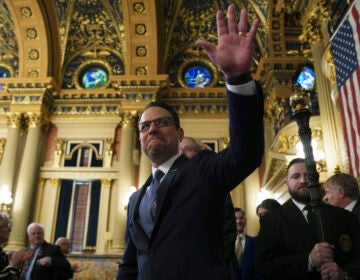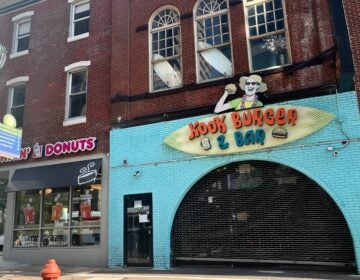Philly building collapse ‘no accident,’ declares attorney as civil case opens
Listen
Robert Mongeluzzi is lead attorney for the plaintiffs in the civil case stemming from the June 2013 Center City building collapse that killed six and injured 13 others. (AP photo/ Matt Rourke)
The consolidated civil complaint filed after a June 2013 deadly building collapse in Center City Philadelphia names nearly two-dozen defendants who could potentially be held financially responsible for the high-profile tragedy that killed six and injured 13 more.
But on Monday, Robert Mongeluzzi, lead attorney for the plaintiffs, largely focused on just four individuals — Richard Basciano, Thomas Simmonds, Plato Marinakos and Griffin Campbell. They are the building’s owner, project manager, owner’s representative, and demolition contractor, respectively.
With the help of videos, photographs, and email excerpts, Mongeluzzi told jurors that the decisions these men made — and didn’t make — directly led to one of the city’s deadliest days in recent history. What’s worse, he said, each of them knew it all along.
“This was no accident,” said Mongeluzzi. “The tragedy of this horror … was that it was expected and it was predicted.”
In 2013, Basciano owned five buildings along the 2100 and 2200 blocks of Market Street. Mongeluzzi said the veteran developer wanted to demolish them as part of a “dream” to build a blocklong project featuring a pair of sparkling towers.
The Hoagie City building was one of the structures Basciano was bringing down. The roughly four-story brick building, constructed before World War II, had been vacant for two decades. It towered above a Salvation Army Thrift Store at 22nd and Market streets.
Shoddy workmanship alleged
Mongeluzzi argued that demolishing the property, the tallest of the five, required a “sophisticated” operation carried out by experts — and that Simmonds, Marinakos and Campbell were anything but experts.
“It was the blind leading the blind leading the blind,” said Mongeluzzi.
Basciano hired Simmonds, who had no experience managing a demolition project, and Marinakos, an architect by trade. Marinakos hired Campbell, whom Mongeluzzi called “clueless.”
Campbell, one of two men criminally charged in connection to the collapse, had never demolished a commercial property or anything as tall as four stories. Until January 2013, he wasn’t a licensed contractor. The only demolition experience he had was taking down a pair of burned-out row homes on Erie Avenue in North Philadelphia. Before that, he ran a food truck for nearly decades.
“This is the last person on Earth who should have been handling this demolition,” said Mongeluzzi.
Campbell was sentenced to 15 to 30 years in prison after a jury convicted him of involuntary manslaughter and aggravated assault.
Mongeluzzi also took aim at Sean Benschop, an excavator operator who worked the site, and the Salvation Army. He promised evidence showing that the national organization is also culpable in the collapse and did nothing to try to save innocent lives.
“The Salvation Army doesn’t live up to its mission statement of doing the most good,” said Mongeluzzi.
Benschop, the other person arrested and charged after the collapse, is serving seven to 15-and-a-half years behind bars after pleading guilty to involuntary manslaughter and aggravated assault.
Basciano, Simmonds, Marinakos, Campbell and Benschop are all expected to testify during what could be a months-long trial.
Opening statements were scheduled to continue after the lunch recess and through the end of the day. Defense attorneys are slated to make their opening statements on Tuesday.
At around 10:42 a.m. on June 5, 2013, an unsupported, three-story brick wall pancaked onto and crushed a busy Salvation Army Thrift Store next door, sending debris and a large dust cloud into one of the city’s busiest intersections.
Chaos ensued as police, firefighters and reporters rushed to the scene.
Profit motivating factor in collapse, lawyer says
More than 12 hours later, six people had lost their lives. Thirteen more had been injured, some seriously.
Mariya Plekan, who had traveled to the store that day to take a break from caring for older relatives, lost both her legs after she was trapped beneath the rubble for roughly 13 hours in a space so tight she couldn’t reach her cell phone to call for help, according to testimony.
Mongeluzzi said all of the suffering could have been avoided in the months and weeks leading up to the collapse.
In the days beforehand, all the lateral supports had been removed from the wall that ultimately collapsed onto the Salvation Army Thrift Store. At the same time, heavy machinery was in use to help with demolition. During Campbell’s trial in October, a demolition and construction expert said the building needed to be taken down top to bottom and by hand.
Mongeluzzi said that was done early on, but that Benschop and his excavator operator were brought in when pressure mounted to get to the job done.
Prosecutors during Campbell’s criminal trial said he was more concerned with profiting from salvaging the buildings guts than safety.
WHYY is your source for fact-based, in-depth journalism and information. As a nonprofit organization, we rely on financial support from readers like you. Please give today.





